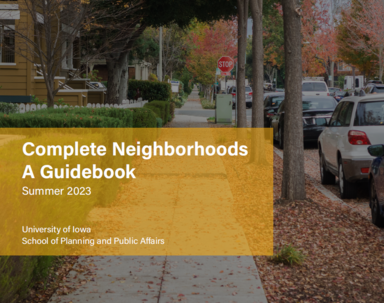What if we were all in walking distance to groceries, medical care, restaurants, schools, recreation centers, and entertainment? This kind of proximity to the needs of daily life used to be the norm. As cities of all sizes have tailored themselves to meet the needs of cars, however, we’ve become accustomed to driving from one hub to another.
Researchers have identified multiple health problems tied to our automobile-centric lifestyles, including obesity and heart disease, crash-related injuries, and loneliness. There are also societal costs, including infrastructure maintenance, climate change and pollution, and the breakup of formerly intact neighborhoods by major roadways.
Tailoring a European model to fit U.S. needs

In 2023, the Corridor Metropolitan Planning Organization (MPO), which is tasked with reviewing and approving transportation investments in the Cedar Rapids metropolitan area, reached out to IISC to learn how they might tailor a 15-Minute City model to suit their needs. Popularized in Europe, this model has had less adaptation in the U.S.
Now, a guidebook to “Complete Neighborhoods” that focuses on mid-sized, U.S. cities provides resources and inspiration. Created by three students in the School of Planning and Public Affairs’ Transportation Certificate program, the nearly 80-page guidebook provides overviews of concepts like supportive development regulations, infill development, and parking requirements.
Steve Spears, an expert in sustainable transportation, taught the 12-week capstone class that resulted in the guidebook. The three student authors—Emily Auster, Kiefer Roman, and Robert Lee—all work in transportation planning offices for different municipalities. The level of their professional experience can be seen, Spears says, in the high quality of the publication, which he views as an ideal resource for many cities.
Each section includes a brief case study, a checklist, and a list of additional resources. At the client’s request, the case studies all come from U.S. cities, such as Ann Arbor, MI, and New Rochelle, NY. Because it’s easier to imagine this model in European cities that are older and, thus, have central neighborhoods designed prior to cars, the team wanted to uplift how this can work here.
No "one size fits all"
Since the mid-aughts, several European cities have embraced the concept of a 15-Minute City—most notably Paris. The Covid-19 pandemic and climate change have heightened cities’ interest in more resilient neighborhoods.
Kiefer says the group wanted to look beyond the 15-Minute City’s focus on transportation. “We homed in on more areas, such as housing and businesses,” he says, adding that they were inspired by American cities prior to Euclidian Zoning. Named after a 1926 U.S. Supreme Court case that upheld zoning districts, this is the most common regulatory method for dividing cities into sectors by land use type, e.g., residential, industrial, commercial.

Overly restrictive zoning and other regulations, such as minimum parking requirements, can be barriers to many of the changes touted by complete neighborhoods. They can also have a homogenizing effect. A key aspect of the Complete Neighborhood guidebook is acknowledgement that each neighborhood has different needs and personalities; there is no “one size fits all.” Spears gives an example of how prior to stricter zoning, it wasn’t uncommon to find a small bakery or barbershop in the street-facing part of a house.
Spears wonders about the effects of bringing this back. “While you would get backlash to this approach in many neighborhoods today, others would embrace it,” he says.
Which is why public engagement is a crucial part of complete neighborhoods. One of the final sections of the guidebook provides resources for involving community members in all phases of visioning, planning, and implementing.
Shifting norms
“As with any initiative that seeks to shift norms, Complete Neighborhoods have received their share of backlash and controversy,” Kiefer, Lee, and Ault write. “The idea of restructuring a community—even if done with the best of intentions—can make some people apprehensive about the future and leave them wondering how their lives will be impacted.”
Since publishing the guidebook in 2023, the Corridor MPO is continuing to review the policies and practices of other cities, including those in the case studies. In recent years, Cedar Rapids has updated its zoning code, expanded the bicycle and trail system, supported its neighborhood associations, and developed a micromobility program.
Travis Kraus, director of IISC and a faculty member in the School of Planning and Public Affairs says he hopes the guidebook can be a tool for other communities. He notes that it fills a niche need: "We know that many cities of various sizes are actively thinking about the issues raised in this book. Written as an introduction with a lot of great resources particular to U.S. cities, this can be an ideal starting point."
